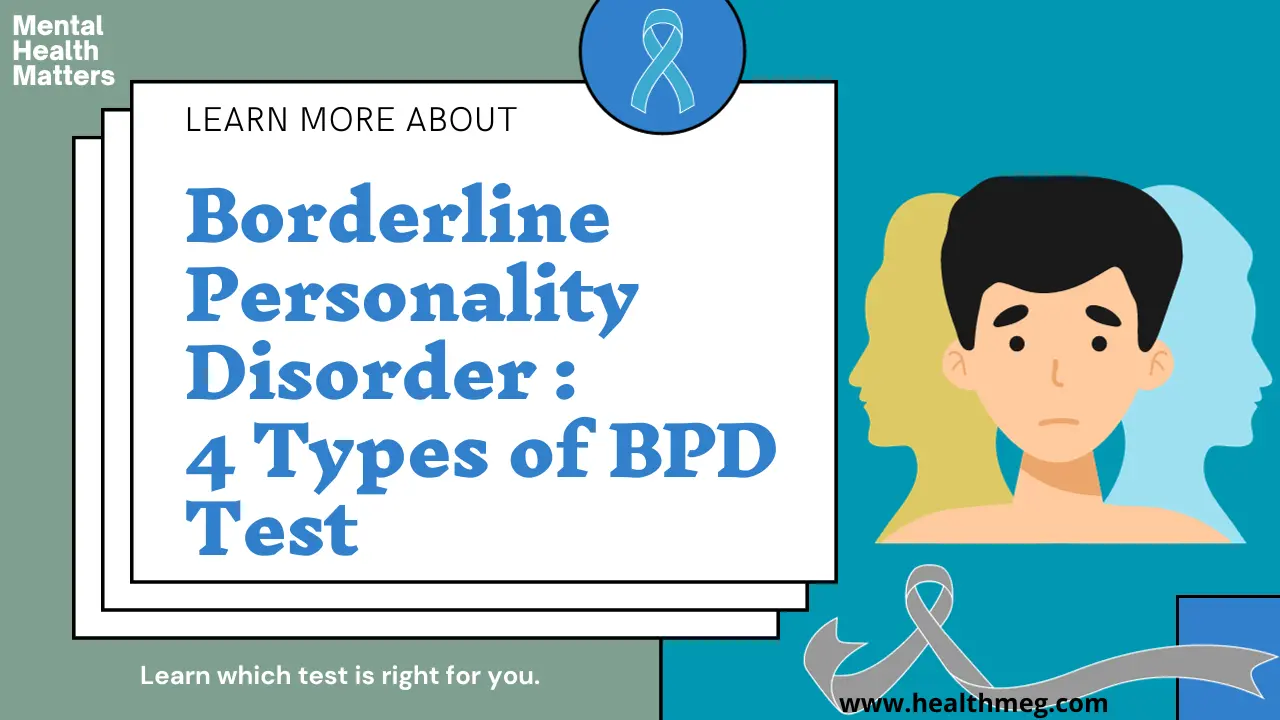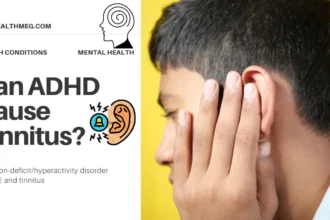Introduction
If you’ve done any research on borderline personality disorder (BPD), you’ve likely encountered various tests and quizzes advertised as ways to “find out if you have BPD.” But how accurately and helpfully do these tests assess BPD symptoms?
In this comprehensive guide, we’ll explore the “4 types of BPD tests” available and the key differences between them. We’ll look at the pros and cons of each test type, so you can determine which option may be most appropriate for your situation.
For each test type, we’ll:
- Explain what it measures and its approach.
- Outline key pros and cons.
- Compare its thoroughness and applicability.
- Detail guidelines for choosing quality assessments.
- Describe how tests fit into the larger diagnostic process.
Let’s dive into demystifying BPD testing options so you can make informed choices.
Do read the People Also Ask (FAQs) about this topic.
Key Takeaways
- Diverse Assessment Approaches: Explore the varied methods, from structured diagnostic questionnaires to DBT assessment tools, used to evaluate Borderline Personality Disorder.
- Early Identification Matters: Early detection through brief screening tools can aid in timely intervention and management of BPD symptoms.
- Tailored Testing: Understand the significance of type-specific BPD tests for a more nuanced and personalized approach to diagnosis.
- Comprehensive Mental Health Support: Emphasize the importance of seeking professional guidance for accurate assessment and ongoing mental health care.
Understanding Borderline personality disorder (BPD)
Borderline personality disorder (BPD) is a complex mental health condition characterized by difficulties regulating emotions, thoughts, and behaviours. People with BPD often experience intense mood swings, impulsive actions, unstable relationships, and a distorted self-image.
While BPD is usually diagnosed by a mental health professional, various self-tests and quizzes can help give you an idea of whether you may have symptoms of BPD. Tests cannot provide an official diagnosis, but they can point you in the right direction in terms of seeking professional help.
Types of BPD Tests (4 Types of BPD Test)
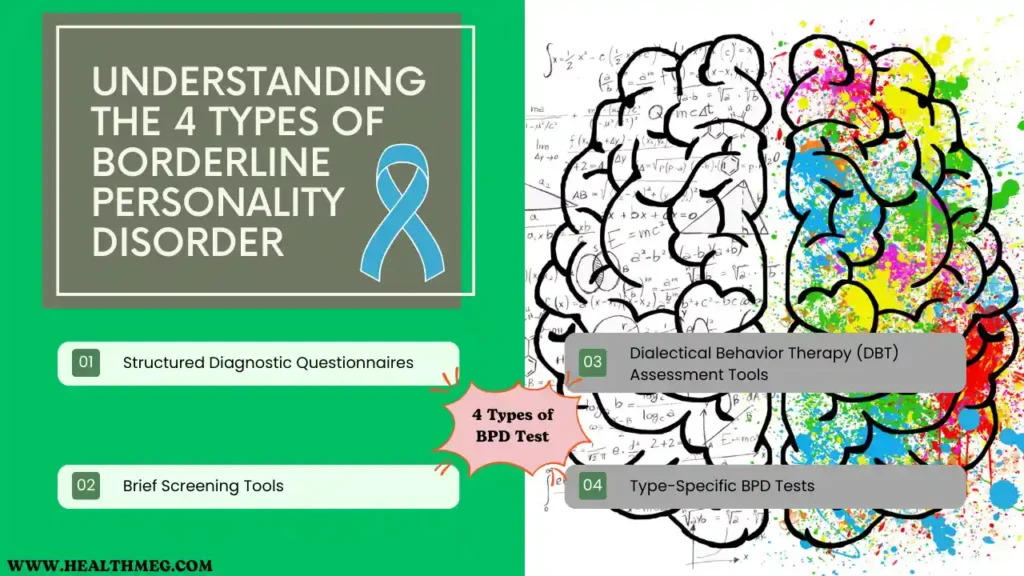
There are a few main types of BPD tests available online and from mental health professionals. Here we will explore the 4 main types of BPD tests and what each one measures.
- Structured Diagnostic Questionnaires
- Brief Screening Tools
- Dialectical Behavior Therapy (DBT) Assessment Tools
- Type-Specific BPD Tests
1. Structured Diagnostic Questionnaires
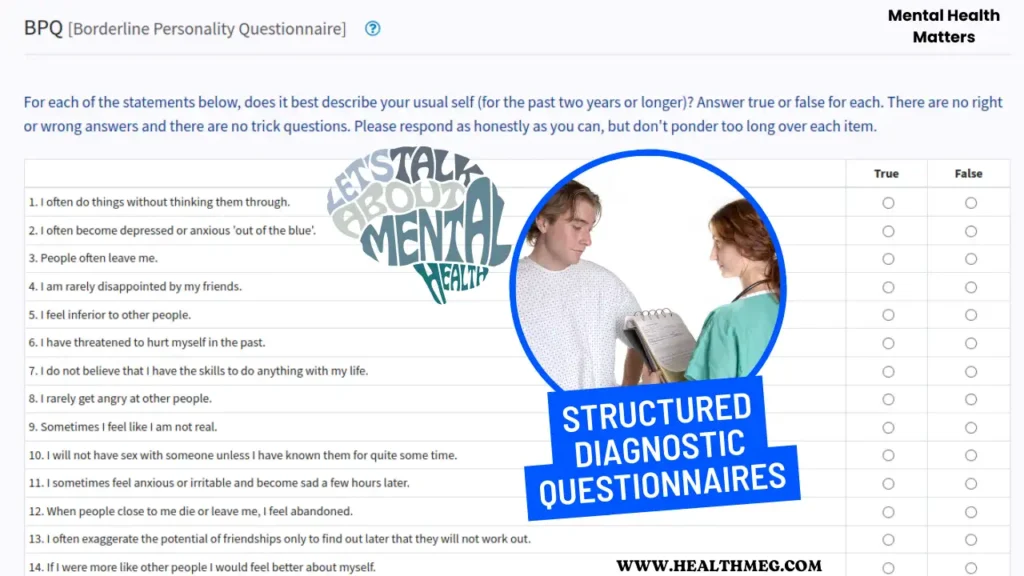
The most robust and thorough BPD tests are structured diagnostic questionnaires designed to systematically assess for the presence of BPD symptoms. These lengthy tests directly evaluate the 9 diagnostic criteria for BPD outlined in the DSM-5, the handbook used by mental health professionals.
Some well-validated examples include:
- The McLean Screening Instrument for Borderline Personality Disorder (MSI-BPD) – contains 160 items covering all 9 BPD criteria and various associated features.
- The Borderline Personality Questionnaire (BPQ) – with 80 items assessing the 9 BPD criteria.
- The Personality Diagnostic Questionnaire (PDQ-4+) – features 107 items evaluating BPD along with other personality disorders.
These questionnaires ask a range of detailed questions about your emotions, behaviours, relationships, self-image, impulsivity, and other areas of functioning. The questions are designed to provide a nuanced profile of symptoms to determine if they align with the diagnostic criteria for BPD.
Pros
- Thorough, systematic assessment directly based on the diagnostic criteria
- Identify the presence and severity of all BPD symptoms
- A high level of detail provides a personalized symptom profile
Cons
- Time intensive – often 70+ lengthy questions
- Should be interpreted by a professional for accurate diagnosis
- Focus on symptoms without contextual insights
Overall, structured diagnostic questionnaires offer the most comprehensive way to screen for BPD symptoms. However, they are best utilized as a part of a complete diagnostic evaluation by a qualified mental health provider.
2. Brief Screening Tools
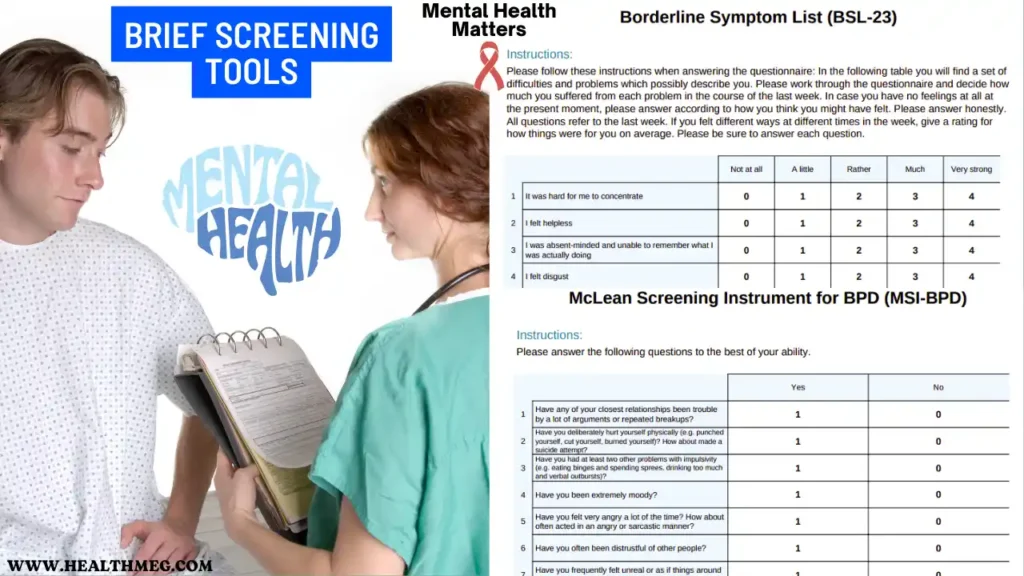
For those wanting a quicker initial gauge of potential BPD, there are shorter screening tools containing 10-30 key questions. These tools serve to indicate whether seeking further professional assessment may be beneficial.
Some examples of brief BPD screening tools include:
- The Standardized Assessment of Personality – Abbreviated Scale (SAPAS) – an 8-item tool assessing BPD traits.
- The McLean Screening Instrument for Borderline Personality Disorder – Short Form (MSI-BPD-SF) – a 10-item version of the longer MSI-BPD.
- The Borderline Symptom List (BSL-23) – a 23-item scale evaluating self-harm, emotions, and relationships. Click Here for the Link
While very accessible and easy to complete, these brief screens are limited in their accuracy and cannot definitively diagnose BPD due to their brevity. But they can point you in the right direction in terms of seeking help.
Pros
- Quick and convenient – often under 15 minutes
- Gives general indication of potential BPD symptoms
- Easy to find and take online
Cons
- Brief format limits nuanced insights
- Higher chance of false positives/negatives
- Cannot diagnose BPD definitively
Brief online screening tools are best used as a preliminary self-check. Consult a professional if your results indicate possible BPD risk.
3. Dialectical Behavior Therapy (DBT) Assessment Tools
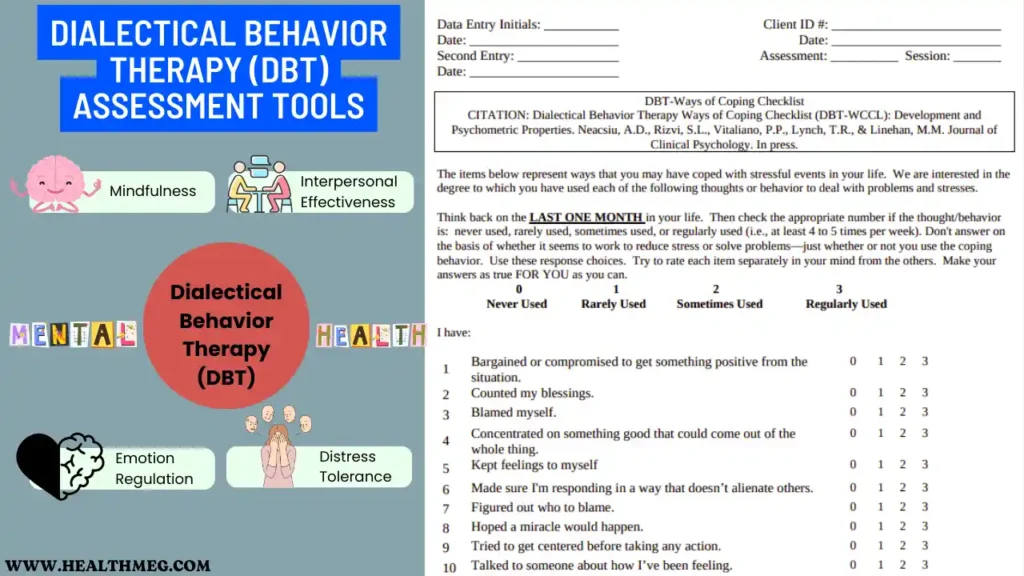
DBT is a specialized therapy approach often used to treat BPD. There are assessment tools designed specifically to evaluate suitability and readiness for DBT treatment programs.
Examples of DBT pre-treatment assessments include:
- The Borderline Personality Disorder Severity Index (BPDSI) – a 45-item scale rating BP traits, behaviours, and impacts.
- The DBT Ways of Coping Checklist (DBT-WCCL) – a 59-item inventory of DBT-relevant coping skills. Click Here for the Link
- The DBT Radical Acceptance Questionnaire (DBT-RAQ) – a 20-item tool measuring acceptance of reality.
These assessments provide insights into symptom severity, problematic behaviours, and coping abilities considered prime targets in DBT. They help determine if a patient is appropriate for and likely to benefit from DBT treatment.
Pros
- Tailored for DBT candidacy and treatment planning
- Evaluate key DBT focus areas like coping skills
- Guide effective DBT treatment approaches
Cons
- Do not give a formal BPD diagnosis
- Mainly useful for those seeking DBT
- Require DBT provider interpretation
For those pursuing DBT for BPD, these assessments can supplement general diagnostic tests. But they should be given by a DBT provider.
4. Type-Specific BPD Tests
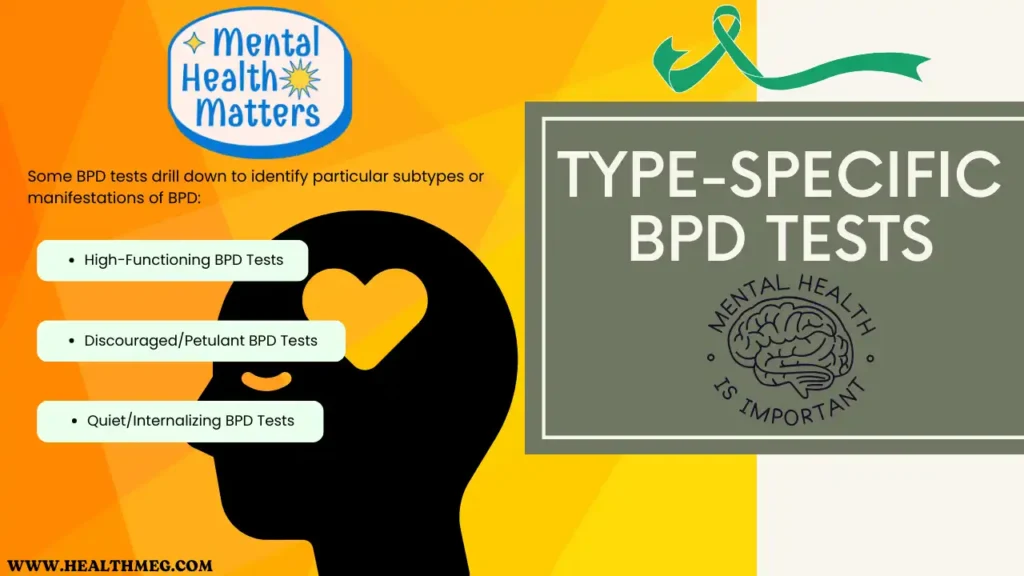
Some BPD tests drill down to identify particular subtypes or manifestations of BPD:
High-Functioning BPD Tests
People with high-functioning BPD can manage their symptoms more effectively than typically in work, relationships, and daily life. Tests like the High-Functioning BPD Test aim to pinpoint areas of struggle those with “quieter” forms of BPD may relate to.
Discouraged/Petulant BPD Tests
Those with the discouraged or petulant subtypes tend to feel chronically disappointed, pessimistic, and resentful. The Personality Style Test assesses for this BPD variant.
Quiet/Internalizing BPD Tests
Individuals who primarily direct their BPD distress and behaviours inward may have the quiet/internalizing subtype. The Quiet Borderline Test screens for this form.
While these type-specific tests can offer helpful insights, they should always be paired with a more comprehensive BPD evaluation. Tests catered to subtypes may miss other significant symptoms.
Pros
- Identify lesser-known variants of BPD
- Reveal nuances beyond a general BPD diagnosis
- Guide tailored treatment approaches
Cons
- Do not substitute for a complete diagnostic assessment
- May pigeon-hole symptoms into one subtype
- Still require professional interpretation
Type-specific BPD tests serve best as a supplement, not an alternative, to more rigorous BPD screening tools.
Finding a Reputable BPD Test Online
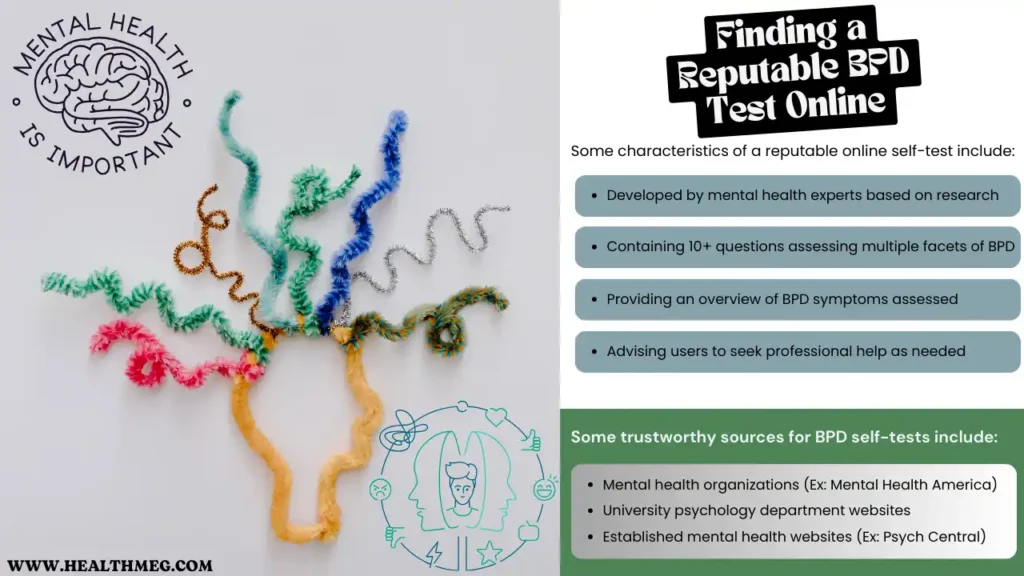
If you’re looking to take a self-screening test for BPD online, make sure to use a scientifically validated tool from a reputable source. Avoid overly simplistic quizzes.
Some trustworthy sources for BPD self-tests include:
- Mental health organizations (Ex: Mental Health America)
- University psychology department websites
- Established mental health websites (Ex: Psych Central)
Some characteristics of a reputable online self-test include:
- Developed by mental health experts based on research
- Containing 10+ questions assessing multiple facets of BPD
- Providing an overview of BPD symptoms assessed
- Advising users to seek professional help as needed
Look for tests meeting these criteria from sources like Mental Health America, McLean Hospital, or academic websites. While convenient, online tests should always be a starting point, not a final say.
Keep in mind that self-tests are meant to give you an idea of whether you may have symptoms, not serve as an official diagnosis. Speak to a mental health professional if your test results indicate you may have BPD.
Symptoms of BPD
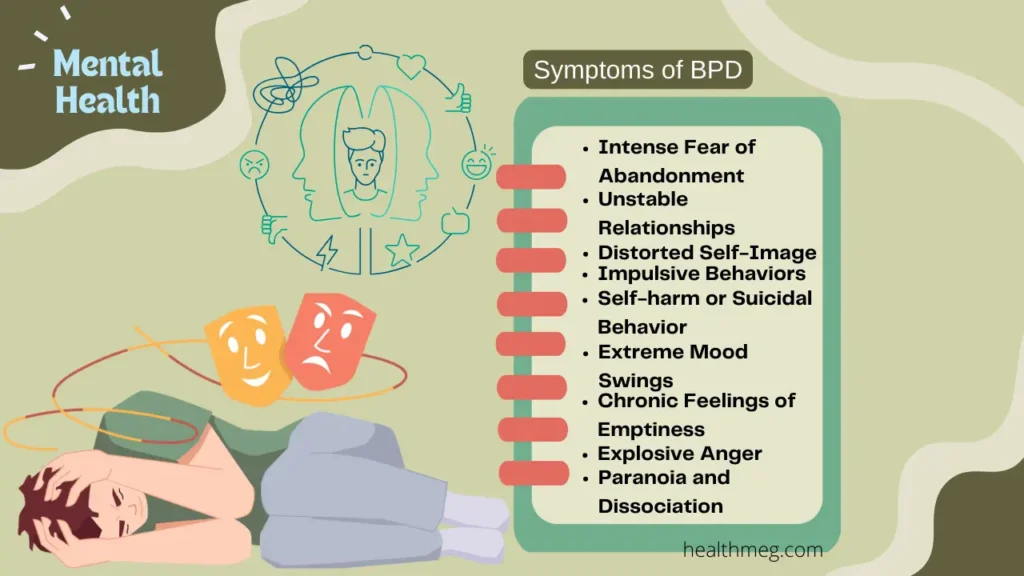
The following are the symptoms of Borderline personality disorder (BPD):-
- Intense Fear of Abandonment: Individuals with BPD often experience overwhelming fears of being abandoned or rejected by others.
- Unstable Relationships: Relationships may be marked by extreme idealization and devaluation, leading to tumultuous dynamics.
- Distorted Self-Image: Individuals with BPD may struggle with a distorted sense of self, self-worth, and identity.
- Impulsive Behaviors: Impulsivity may manifest in reckless activities such as substance abuse, binge eating, or risky sex.
- Self-Harm or Suicidal Behavior: BPD is associated with a higher risk of self-harming behaviours and suicidal ideation.
- Extreme Mood Swings: Emotional instability and intense mood swings, lasting from a few hours to a few days.
- Chronic Feelings of Emptiness: Individuals with BPD may experience persistent feelings of emptiness and boredom.
- Explosive Anger: Difficulty controlling anger, leading to intense, inappropriate outbursts.
- Paranoia and Dissociation: Transient episodes of paranoia or dissociation may occur under stress.
- Unstable Sense of Morality: Values, goals, and loyalties may change rapidly, leading to confusion and conflicts.
These are some of the important symptoms that show Borderline personality disorder (BPD).
Getting an Evaluation from a Mental Health Professional
To get an accurate BPD diagnosis, it’s essential to see a qualified mental health provider like a psychologist or psychiatrist. They can properly administer and interpret validated diagnostic tools and also draw from their clinical experience.
In addition to using structured tests, mental health professionals will:
- Thoroughly assess symptoms – Explore details of your symptoms and mental health history through in-depth conversations and questions.
- Check for related conditions – Rule out disorders like bipolar, PTSD, and others with overlapping symptoms.
- Gather collateral information – Speak with loved ones familiar with your behaviours to get an outside perspective.
- Evaluate symptom impacts – Determine how significantly symptoms impair your relationships, work, self-care, and other areas of functioning.
- Interpret results accurately – Contextualize test results using clinical experience with BPD patients and diagnostic standards.
- Develop a personalized treatment plan – Recommend tailored, evidence-based treatment approaches to address your unique situation and struggles with compassion.
This comprehensive diagnostic process allows for a detailed understanding of your unique situation, which self-tests alone cannot offer. Online screenings are a helpful preliminary check, while professional evaluations deliver actionable answers.
Conclusion: Finding the Right BPD Test Approach
In determining if BPD testing may be helpful for you, consider these key points:
- Structured diagnostic questionnaires provide the most thorough assessment but require professional administration.
- Brief screening tools help indicate if further BPD evaluation may be useful.
- DBT tools specifically evaluate suitability for DBT treatment.
- Type-specific tests narrow in on certain variants of BPD.
- Reputable online self-tests can gauge if professional help may be needed.
- Mental health professionals conduct comprehensive evaluations for accurate diagnoses.
Testing can be an empowering first step in better understanding the symptoms of BPD. However, testing should ideally be partnered with professional support to determine the appropriate next steps in terms of diagnosis and treatment. Reach out to a qualified mental health provider if you have concerns about BPD.
People Also Ask (FAQs)
Q) How can I check if I have BPD?
A) To check if you have BPD, consider seeking professional help and undergo evaluations using structured diagnostic questionnaires or assessments specifically designed for BPD. Based on your symptoms and experiences, A mental health professional can provide an accurate diagnosis.
Q) Does BPD go away?
A) Borderline Personality Disorder (BPD) is a chronic condition, but with appropriate treatment such as therapy (Dialectical Behavior Therapy or DBT), individuals can learn to manage symptoms effectively. While it may not completely go away, many people with BPD experience significant improvement in their quality of life.
Q) Can I test myself for BPD?
A) It is not advised to self-test for Borderline Personality Disorder (BPD). Seeking advice from mental health specialists or professionals is important because they are capable of carrying out a thorough assessment, accurately diagnosing you, and offering assistance based on your unique experiences and symptoms.
Q) How does BPD develop?
A) The complex interaction of genetic, environmental, and neurological variables contributes to the development of Borderline Personality Disorder (BPD). Traumatic experiences, particularly during childhood, can play a significant role in its onset.
Q) What are the 3 C’s of BPD?
A) The 3 C’s are:
- I didn’t cause it.
- I can’t cure it.
- I can’t control it.
Q) What brain type is BPD?
A) Emotional regulation and impulsivity are two areas of the brain where BPD is linked to changes in brain structure and function. Changes like these have an impact on both the prefrontal cortex and limbic system, which may explain why people diagnosed with BPD frequently exhibit or show impulsive behaviour and lack of emotional regulation (emotional dysregulation).
Q) What are the 10 symptoms of BPD?
A) Important Symptoms of BPD are:-
- Intense Fear of Abandonment
- Unstable Relationships
- Distorted Self-Image
- Impulsive Behaviors
- Self-harm or Suicidal Behavior
- Extreme Mood Swings
- Chronic Feelings of Emptiness
- Explosive Anger
- Paranoia and Dissociation
- Unstable Sense of Morality
References
- Mental Health America
- Website: www.mhanational.org
- McLean Hospital
- Website: www.mcleanhospital.org
- Psych Central
- Website: www.psychcentral.com
- Diagnostic Statistical Manual of Mental Disorders, Fifth Edition (DSM-5):
- International Statistical Classification of Diseases and Related Health Problems, Eleventh Revision (ICD-11):
- Website: https://icd.who.int/en/
- American Psychiatric Association (APA):
- Website: https://www.psychiatry.org/
- National Alliance on Mental Illness (NAMI):
- Website: https://www.nami.org/Home
- Borderline Personality Disorder Resource Center:
- Website: https://bpdresourcecenter.org/
- The National Institute of Mental Health (NIMH):
- Website: https://www.nimh.nih.gov/
